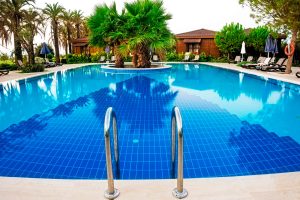Residential License # 890459
Commercial License # 3667

Talk to an Expert
Residential License # 890459
Commercial License # 3667

Talk to an Expert
Choosing the appropriate pool finish may make a significant impact on a pool’s beauty, lifespan, and ease of care. From a low-cost plaster finish to a pebble-textured surface or a high-end tile installation, each option has pros and cons. Knowing the benefits and drawbacks of various pool finishes allows homeowners to make decisions that reflect their preferences and future maintenance needs.
TurnKey Pool Designers provides experienced assistance in selecting the best pool finish in terms of beauty, cost, and maintenance.
Pool finishes decide the interior finish of a swimming pool and contribute to its overall attractiveness and ambiance. Technology has allowed various styles with improvements in material, enabling one to customize depending on varying tastes, ranging from modern and minimalistic to natural and vintage.
Apart from looks, pool finishes shield the structure and influence water retention, minimizing leaks and long-term breakdown. Accurate material choice brings longevity while keeping maintenance under control.
Pool finishes are the substances used inside the pool, forming a waterproof seal and beautifying the pool. It could be a high-end option, such as plaster, an aggregated mixture of quartz or pebbles, or a high-end option, such as tiles or glass beads. They each have different textures and durability values and are more resistant to wear and chemicals.
A pool finish is a substance placed on the inside surface, forming a watertight covering as well as beautifying the appearance of the pool. Choices include traditional white plaster to premium glass tiles, all giving different advantages. Glass tiles are poreless and extremely durable, while pebble finishes offer a natural, textured look that blends well with outdoor environments.
A long-lasting finish adds years to the life of the pool, improves its appearance, and saves on maintenance. Quartz or granite fleck finishes last for 12–20 years, whereas high-quality glass bead finishes refract sunlight beautifully and need less repair.
 fordable
fordableThe most popular finish in the pool is plaster, which offers a classic, smooth look at the expense of standard wood. This pool is simple and clean and is also handmade to offer an elegant look, and is still popular with homeowners who want it to be inexpensive.
Plaster made from white Portland cement and pulverized marble feels silky and smooth. The white plaster (marcite), most often available, produces a fresh, classic appearance.
Plaster is a good option for those looking for an old-fashioned appearance without initially spending a significant amount, but it needs to be serviced often.
Classic plaster becomes more durable and visually appealing with aggregate finishes like quartz, pebbles, or glass beads. This improvement enhances texture, strength, and overall appearance.
The aggregated surface, made up of cement and natural materials, offers several different textures and colors. The exposed, aggregated accents display the stone, while the refined total value gives a refined, smooth finish.
Finishes such as Pebble Tec expose embedded stones, producing a textured, slip-resistant surface with a natural appearance.
Grinding smooths the surface, bringing out the material’s natural luster. Quartz choices provide an affordable yet fashionable option.
Aggregate finishes, especially pebble and quartz types, provide a mix of style and durability and are a good investment for long-term pool owners.

Tile is the most costly pool finish, but its style and longevity make it well worth it. It makes any pool a dramatic centerpiece, marrying functionality with luxury.
These include glazing the surface of the pool with individual tiles. They make it possible for complex patterns, bright colors, and even mosaic art.
Long-lasting and affordable with a smooth, glass-like sheen. Custom paint designs give them personality.
This provides an earthy, natural appearance that works well outdoors. Saltwater and chlorine-resistant.
Non-porous, resistant to stains, and highly reflective for a stunning underwater effect.
The surface of the tile takes over 20 years, but initially, it is expensive and needs to be adapted properly. Regular maintenance is required to avoid calcium formation. This means losing its appearance.
Longevity of pool finishes is a significant consideration in determining maintenance and value. Depending on maintenance and environment, plaster, tile, and aggregate all have unique benefits and drawbacks.
Plaster finishes, traditional white or colored, normally have a lifespan of 5 to 10 years. Proper water chemistry averts etching and calcium scaling, which decreases their lifespan. Brushing regularly and making immediate repairs increases durability. Plaster is more prone to staining and needs resurfacing more frequently than aggregate or tile.
Aggregate finishes, such as Pebble Tec or Diamond Brite, mix cement with stones or quartz for a more durable surface. With proper maintenance, Pebble Tec will last 30+ years. Aggregate does not fade or crack like plaster but does appreciate occasional acid washing, particularly in hard water areas.
Finishes on tile last forever, without chemicals or external influences affecting them. Glass and ceramic tile last decades, with colors and glaze intact—some well over 80 years. Grout that is properly maintained avoids algae growth, making tile the longest-lasting, most elegant choice.
Budget considerations play a significant role in selecting a pool finish. Here’s a breakdown of the costs involved:
Labor costs, pool size, and material selection all impact the final price. While plaster has the lowest upfront cost, aggregate and tile finishes offer longer-term value through durability and reduced resurfacing needs.
Tiles are the most expensive at first, but are of the greatest long-term value as they are extremely durable and require little maintenance.
Eco-friendly pool coatings help make it sustainable. Tile and aggregate are greener than plaster, as they minimize waste and resurfacing. Porous finishes, such as glass tile, help conserve water, reducing evaporation and chemical uptake.
The right pool finish balances style, comfort, and maintenance. Plaster is budget-friendly but needs more upkeep; aggregate blends durability with natural beauty; and tile delivers long-lasting elegance at a higher cost. Each option shapes the pool’s look and feel, making it an essential part of your design.
At TurnKey Pool Designers, we help you choose the ideal finish for your pool. Let’s create a pool that fits your vision—reach out to us today!